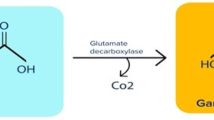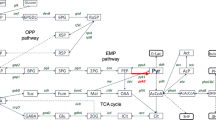Abstract
This study demonstrates that cytoplasmic malate dehydrogenase (MDH-s) catalyzes the reduction of aromatic alpha-keto acids in the presence of NADH, that the enzyme which has been described in the literature as aromatic alpha-keto acid reductase (KAR; EC 1.1.1.96) is identical to MDH-s, and that the reduction of aromatic alpha-keto acids is due predominantly to a previously unrecognized secondary activity of MDH-s and the remainder is due to the previously recognized activity of lactate dehydrogenase (LDH) toward aromatic keto-acids. MDH-s and KAR have the same molecular weight, subunit structure, and tissue distribution. Starch gel electrophoresis followed by histochemical staining using eitherp-hydroxyphenylpyruvic acid (HPPA) or malate as the substrate shows that KAR activity comigrates with MDH-s in all species studied except some marine species. Inhibition with malate, the end product of the MDH reaction, substantially reduces or totally eliminates KAR activity. Genetically determined electrophoretic variants of MDH-s seen in the fresh water bony fish of the genusXiphophorus and the amphibianRana pipiens exhibited identical variation for KAR, and the two traits cosegregated in the offspring from oneR. pipiens heterozygote studied. Both enzymes comigrate with no electrophoretic variation among several inbred strains of mice. Antisera raised against purified chicken MDH-s totally inhibited both MDH-s and KAR activity in chicken liver homogenates. There is no evidence to suggest that any protein besides MDH-s and LDH catalyzes this reaction with the possible exception of the situation inXiphophorus, in which a third independent zone of HPPA reduction is observed. In most species the activity formerly described as KAR appears to be due to a previously unsuspected activity of MDH-s toward aromatic monocarboxylic alpha-keto acids. In all species examined the KAR activity is associated only with MDH-s; in tissue homogenates the mitochondrial form of MDH (MDH-m) is not detected after electrophoresis using HPPA as a substrate.
Similar content being viewed by others
References
Batelli, F., and Stern, L. (1910). Oxydation des acides malique, fumarique et citrique par les tissus animaux.C.R. Soc. Biol. 62(II):552.
Davidson, R. G., and Cortner, J. A. (1967a). Genetic variants of human erythrocyte malate dehydrogenase.Nature 215761.
Davidson, R. G., and Cortner, J. A. (1967b). Mitochondrial malate dehydrogenase: A new genetic polymorphism in man.Science 1571569.
Davies, D. D. (1961). The specificity of malic dehydrogenase from higher plants.Biochem. J. 8093.
Davies, D. D., and Kun, E. (1957). Isolation and properties of malic dehydrogenase from ox-heart mitochondria.Biochem. J. 66307.
Donald, L. J. (1982). A description of human aromatic alpha-keto acid reductase.Ann. Hum. Genet. 46299.
Fersht, A. (1977).Enzyme Structure and Mechanism W. H. Freeman, San Francisco, p. 298.
Friedrich, C. A., and Ferrell, R. E. (1985). A population study of alpha-keto acid reductase.Ann. Hum. Genet. 49111.
Friedrich, C. A., Ferrell, R. E., Siciliano, M. J., and Kitto, G. B. (1988). Biochemical and genetic identity of alpha-keto acid reductase and cytoplasmic malate dehydrogenase from human erythrocytes.Ann. Hum. Genet. (in press).
Graves, J. L., Vennesland, B., Utter, M. F., and Pennington, R. J. (1956). The mechanism of the reversible carboxylation of phosphoenolpyruvate.J. Biol. Chem. 223551.
Jornvall, H. (1980). Primary structures of dehydrogenase: Evolutionary characteristics related to functional aspects; Models of isozyme developments and ancestral connections. In Jeffery, J. (ed.),Dehydrogenases Birkhauser Verlag, Boston, pp. 126–148.
Kitto, G. B., and Kaplan, N. O. (1966). Purification and properties of chicken heart mitochondrial and supernatant malic dehydrogenases.Biochemistry 53966.
Leakey, T. E. B., Coward, A. R., Warlow, A., and Mourant, A. E. (1972). The distribution in human populations of electrophoretic variants of cytoplasmic malate dehydrogenase.Hum. Hered. 22542.
Loewus, F. A., Tchen, T. T., and Vennesland, B. (1955). The enzymatic transfer of hydrogen. III. The reaction catalyzed by malic dehydrogenase.J. Biol. Chem. 212787.
Morizot, D. C., and Siciliano, M. J. (1982). Protein polymorphisms, segregation in genetic crosses and genetic distances among fishes of the genusXiphophorus (Poeciliidae).Genetics 102539.
Nakano, M., Tsutsumi, Y., and Danowski, T. S. (1970). Aromatic alpha-keto acid reductase from rat kidney.J. Biol. Chem. 2454443.
Scholefield, P. G. (1955). The oxidation of malic and mesotartaric acids in pigeon-liver extracts.Biochem. J. 59177.
Shows, T. B., Chapman, V. M., and Ruddle, F. H. (1970). Mitochondrial malate dehydrogenase and malic enzyme: Mendelian inherited electrophoretic variants in the mouse.Biochem. Genet. 4707.
Siciliano, M. J., and Shaw, C. R. (1976). Separation and visualization of enzymes on gels. In Smith, I. (ed.),Chromatographic and Electrophoresis Techniques, Vol. 2 Wm. Heinemann, London, pp. 185–209.
Syke, G. E., and Ebner, K. E. (1965). Reduction of aromatic keto acids by rat liver.Biochim. Biophys. Acta 96331.
Weber, W. W., and Zannoni, V. G. (1966). Reduction of phenylpyruvic acids to phenyllactic acids in mammalian tissues.J. Biol. Chem. 2411345.
Zannoni, V. G. (1970). Aromatic alpha-keto acid reductase. InMethods in Enzymology, Vol. 17A, p. 665.
Zannoni, V. G., and Weber, W. W. (1966). Isolation and properties of aromatic alpha-keto acid reductase.J. Biol. Chem. 2411340.
Author information
Authors and Affiliations
Additional information
This research was supported by a predoctoral fellowship from the Rosalie B. Hite Foundation, a John A. Beck Scholarship from the Houston Endowment, a Freshman Medical Student Summer Research Program Fellowship from M. D. Anderson Hospital, and a Charles A. Dana Foundation/American Federation for Aging Research Scholarship.
Rights and permissions
About this article
Cite this article
Friedrich, C.A., Morizot, D.C., Siciliano, M.J. et al. The reduction of aromatic alpha-keto acids by cytoplasmic malate dehydrogenase and lactate dehydrogenase. Biochem Genet 25, 657–669 (1987). https://doi.org/10.1007/BF00556210
Received:
Revised:
Issue Date:
DOI: https://doi.org/10.1007/BF00556210




